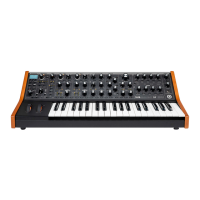28
FILTER SECTION
The number and relative strengths of a sound’s harmonic
frequencies determine its tone color or timbre. The Sub 37
contains a filter for removing certain frequencies from audio
signals. Because filtering gives you control over an audio signal’s
harmonic content, it physically alters the waveform being filtered.
The Sub 37 has a classic Moog Lowpass Ladder Filter with four
selectable slopes. Lowpass filters pass all frequencies up to
a point called the cutoff frequency and gradually roll off, or
attenuate, frequencies above that point. You can change the
cutoff manually using the knob, or you can change it by applying
a signal from a control source such as an envelope or LFO.
Turning the cutoff all the way down closes the filter so that
nothing passes through it. Raising the cutoff opens the filter. As
you turn the CUTOFF knob clockwise from its lowest position,
first you’ll hear only the audio signal’s lowest frequencies, and
then the timbre will grow gradually brighter. The filter envelope,
in combination with the CUTOFF knob’s setting, is the filter’s
primary control source.
Another characteristic of the Sub 37’s filter is resonance.
Resonance increases the level of audio frequencies closest to
the cutoff frequency by making the filter roll off frequencies less
gradually. It regenerates those frequencies by feeding them back
to the filter. Turning up the resonance emphasizes harmonics
closest to the cutoff frequency and exaggerates any changes to
the cutoff frequency.
FILTER CONTROLS
CUTOFF
Use this knob to change the filter’s cutoff frequency. Its lowest setting is 20Hz, which effectively closes
the filter and doesn’t allow any audio to pass through. Its highest setting is 20kHz, which opens the
filter completely and allows all audio to pass through.
RESONANCE
Use this knob to control how much signal is routed from the filter’s output back to its input. Turning it
clockwise increases the resonance, causing a peak in amplitude at the cutoff frequency. Settings above
7 cause the filter to self-oscillate.
MULTIDRIVE
MultiDrive is the Sub 37’s distortion processor, offering effects ranging from asymmetrical, tube-like
warmth to aggressive hard clipping, with a smooth continuous transition in between. The MULTIDRIVE
knob controls how hard you drive the OTA and FET stages, which are located between the filter
and the amplifier in the signal path. The higher the setting, the more aggressive the clipping effect.
Varying amounts of MultiDrive can give your sounds a distinct tonal edge, as well as make them more
responsive to changes in filter resonance, waveform, and oscillator levels.

